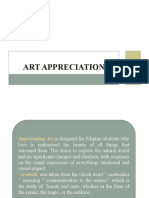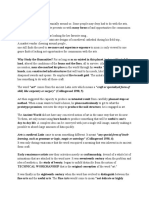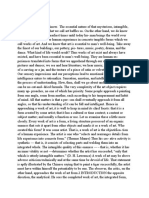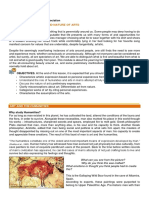Activity.3 (Art Appreciation)
Activity.3 (Art Appreciation)
Uploaded by
Gem CamachoCopyright:
Available Formats
Activity.3 (Art Appreciation)
Activity.3 (Art Appreciation)
Uploaded by
Gem CamachoOriginal Title
Copyright
Available Formats
Share this document
Did you find this document useful?
Is this content inappropriate?
Copyright:
Available Formats
Activity.3 (Art Appreciation)
Activity.3 (Art Appreciation)
Uploaded by
Gem CamachoCopyright:
Available Formats
Assumptions of art
Latin, arts which means “craft or specialized form of skill.” Collingwood, 1938 Ars in Medieval Latin
meant “any special form of book- learning, such as grammar or logic, magic or astrology.”
Assumptions of arts 1. Art is universal Timeless, spanning generations and continents through and
through. Misconception: Artistic made long time ago. Age is not a factor in determining art. “Art is not
good because it is old, but old because it is beautiful.” (Dudley, et al. 1960)
Art is universal, because it evokes an emotional response from us if it is doing the job well. The best art
is beautiful and inspires awe. Or joy. But it evokes emotion. Some art, such as illustration, tells a story or
shows you fantastic places or people. Some art has a specific style that appeals to certain groups of
people. And then you’ve got decades of various attempts to come up with original movements in art.
Some of them are great some of them are pure trash. But art and the value of it is in the eye of the
beholder. But I can look at art from people who do not speak my language, and it speaks to me visually,
and emotionally. Or even with humor. Some art we don’t even recognize as art.
In reality, art is everywhere we look. It’s on the signs we read, on the clothing we wear, on the packages
of everything we buy, on the building as we drive past, in the shape and design of the vehicles we drive.
And I haven’t even begun to scratch the different categories of art. From sculpture, architecture, to
photography, and much much more. Art is far richer, and far more powerful then we give credit for. The
more deeply you examine it, the more you find is still there.
* Art really isn't universal.
All cultures produce Art. But the cues, context and symbol/ symbol, object/symbol, concept/symbol
relationships are products of those particular culture, it's history and collective experience.
But the meaningful Experience of the art is relevant to those who understand the symbol links indicated
above. They create the context which meaning and feeling must stem from. There, by the way a huge
number of symbol links beyond the few I mentioned. What would a Mayan made of Mickey Mouse?
Would they know it was a mouse?
The Mayan Mouse Glyphbabove depicts a mouse. Doesn't look much like a mouse.
Mickey Mouse doesn't look like a mouse either.
This, in art theory is a Symbol / concept mismatch. Both are expressing a symbol of “mouse” but it is
unlikely that with culture would recognize the other's symbol.
If your question was meant to be “Why do all cultures produce art (universally)?” Then we were into
cultural anthropology.
Cultures produce art to
1)Communicate internally (traditional costumes, dance, music, crafts, etc, etc)
2) Communicate externally (identify inculsion or exclusion with in social group or tribe).
Throughout history, the production of 'art for arts sake' is a marker of certian definite types of cultural
development.
Most art from human history is functional. Art is applied to every day items. Patterns in fabric, designs
on containers as decoration.
The reasons for this are the foundations of the universality you.may have been indication.
To personalize by custom adornment (Internal communication Thogra's Hammer has the snake carved
into.the handle)…
Or to show inclusion, accomplishment or social status (The women in the P'tah people receive
distinctive facial tattoos after bearing children). (External Communication).
The 'universiality of art' is at it's very roots, a part of the human condition. It is a defiiner of who we are
as a species, and one of the truest things that uniquely identifies us as human.
Thank you for your question.
Assumptions of arts 1. Art is universal Works of Rizal and Francisco Balagtas Not read because they are
old but they are beautifully written. Arts regardless of origin, time, and place are liked and enjoyed by
people continuously.
Assumptions of arts 2. Art is not nature. Man’s expression of his reception of nature Man’s way of
interpreting nature. Art is made by man, whereas nature is a given around us.
Assumptions of arts 2. Art is not nature. Art, not directed by representation of reality, is a perception of
reality. Five blind men touching an elephant Art has its reason why the artist made it. What is it that he
wants to show?
Assumptions of arts 3. Art involves experience. It does not full detail but just an experience. “Actual
doing of something.” Radio DJ, Choreographer, Painter, Sculptor “All art depends on experience, and if
one is to know art, he must know it not as fact or information but as experience.”
You might also like
- The Art Instinct: Beauty, Pleasure, and Human EvolutionFrom EverandThe Art Instinct: Beauty, Pleasure, and Human EvolutionRating: 3 out of 5 stars3/5 (4)
- Lesson 1 and 2 PPT Art AppreciationDocument41 pagesLesson 1 and 2 PPT Art AppreciationAngel CastilloNo ratings yet
- Estates Notes 2Document146 pagesEstates Notes 2André Le Roux91% (11)
- Developments in Work and Organizational Psychology, Volume 20 - Implications For International Business (International Business and Management) (International Business and Management) PDFDocument315 pagesDevelopments in Work and Organizational Psychology, Volume 20 - Implications For International Business (International Business and Management) (International Business and Management) PDFrijorajanmathewNo ratings yet
- Sample Talent Management QuestionnaireDocument1 pageSample Talent Management Questionnairelovetonight_mohapatra121No ratings yet
- Project Proposal For Constructing New DepartmentDocument2 pagesProject Proposal For Constructing New DepartmentMomin KhanNo ratings yet
- Basic Research Paper (Project)Document7 pagesBasic Research Paper (Project)Judilyn Barba100% (1)
- Biometric Change FormDocument1 pageBiometric Change FormAgha Khan Durrani75% (8)
- I. Topic: Assumptions and Nature of ArtsDocument15 pagesI. Topic: Assumptions and Nature of ArtsJulian CasibangNo ratings yet
- ASSUMPTIONS AND NATURE OF ARTS Hardcopy For MeDocument6 pagesASSUMPTIONS AND NATURE OF ARTS Hardcopy For Meodessa urgelNo ratings yet
- Pointers To Review in Art AppreciationDocument16 pagesPointers To Review in Art AppreciationLianNo ratings yet
- ART Appreciation GE Core 6Document18 pagesART Appreciation GE Core 6rexdormentes6No ratings yet
- Art AppDocument3 pagesArt AppHannah Bless SalvadorNo ratings yet
- Week 2Document4 pagesWeek 2Edmar PerveraNo ratings yet
- Ge 103Document11 pagesGe 103Mary sheila OgaresNo ratings yet
- What Is Art? Introduction and AssumptionsDocument11 pagesWhat Is Art? Introduction and AssumptionsArvinjohn GacutanNo ratings yet
- Arts LessonDocument8 pagesArts LessonJcNo ratings yet
- Chapter 1Document22 pagesChapter 1Kisha Claire RefamonteNo ratings yet
- Definition and Functions of ArtDocument12 pagesDefinition and Functions of ArtIt is MeNo ratings yet
- Lesson 1 What Is An ArtDocument11 pagesLesson 1 What Is An ArtJi-so Elai TselaiNo ratings yet
- What Is Art Module 1Document6 pagesWhat Is Art Module 1John Paul PeressNo ratings yet
- Reviewer Art Appreciation (College)Document16 pagesReviewer Art Appreciation (College)genniejehodoNo ratings yet
- Module in CartDocument73 pagesModule in CartPiyoNo ratings yet
- Lesson 1 The Meaning and Importance of ArtsDocument4 pagesLesson 1 The Meaning and Importance of ArtsVernadel Apollo50% (2)
- Lesson 1 What Is ArtDocument68 pagesLesson 1 What Is ArtrosalieNo ratings yet
- Art AppreciationDocument30 pagesArt AppreciationAngela CruzNo ratings yet
- GE-AA Course Module (Midterm Coverage)Document15 pagesGE-AA Course Module (Midterm Coverage)Quibong, Genard G.No ratings yet
- Art Introduction & AssumptionsDocument34 pagesArt Introduction & Assumptionsq8phzvrkm8No ratings yet
- Mimesis - Is The Ancient Greek Word For Art Which Means To Mimic or To ImitateDocument10 pagesMimesis - Is The Ancient Greek Word For Art Which Means To Mimic or To Imitatetaw realNo ratings yet
- SS123 Midterm Highlighted Important DetailsDocument11 pagesSS123 Midterm Highlighted Important DetailsVea Dela RamaNo ratings yet
- WHAT IS ART IntroductionDocument5 pagesWHAT IS ART IntroductionJomila LeponNo ratings yet
- Ge116 Art Appreciation ModuleDocument85 pagesGe116 Art Appreciation ModuleGodwin Pareñas-Mallorca RoderoNo ratings yet
- Art ReviewerDocument10 pagesArt ReviewerJohn Stephen CastilloNo ratings yet
- Module 1 - What Is Art-Introduction and AssumptionsDocument8 pagesModule 1 - What Is Art-Introduction and AssumptionsJanella Marie BautistaNo ratings yet
- Art App ReviewDocument8 pagesArt App ReviewembalingitNo ratings yet
- Art Appreciation Lesson 1-3Document34 pagesArt Appreciation Lesson 1-3John Robert GasbanNo ratings yet
- Art Appreciation: Ms. Glaidel C. Dela Cruz, LPTDocument25 pagesArt Appreciation: Ms. Glaidel C. Dela Cruz, LPTmysterioushumane100% (1)
- Gart-Prelims ReviewerDocument9 pagesGart-Prelims Reviewerflxpf2251095No ratings yet
- An Introduction To Art AppreciationDocument32 pagesAn Introduction To Art AppreciationHersey Ann AmadorNo ratings yet
- I. Know The Meaning of The Following Terms 1. HumanitiesDocument7 pagesI. Know The Meaning of The Following Terms 1. HumanitiesSiiJuliusKhoNo ratings yet
- Lesson 1 What Is ArtDocument11 pagesLesson 1 What Is ArtJanna Andrea GeneraloNo ratings yet
- GE 103 FinalDocument5 pagesGE 103 FinalScherzando ParohinogNo ratings yet
- GEC 106 - Supplement HandoutsDocument8 pagesGEC 106 - Supplement HandoutsApril FlorendoNo ratings yet
- Chaps 1-2 REmedios, ARt AppreDocument24 pagesChaps 1-2 REmedios, ARt AppreArol Shervanne SarinoNo ratings yet
- Art Appreciation: Alva Nicole A. QuijadaDocument37 pagesArt Appreciation: Alva Nicole A. QuijadatrancebreakerNo ratings yet
- Art AssumtionsDocument3 pagesArt AssumtionsEricka De ClaroNo ratings yet
- Group 1 - Assumptions of ArtDocument22 pagesGroup 1 - Assumptions of ArtDarlingg佐々木 琲世No ratings yet
- Art Appreciation ModuleDocument31 pagesArt Appreciation ModuleShae ShaeNo ratings yet
- Art Appreciation Prelim ModuleDocument14 pagesArt Appreciation Prelim ModuleCristine Mae CastroNo ratings yet
- AA ReviewerDocument7 pagesAA ReviewerAllana Millizenth C. LabasanNo ratings yet
- Art-Appreciation PREDocument96 pagesArt-Appreciation PRETagalag, Markgil M.No ratings yet
- Course Outline Unit 1: Introduction To Art AppreciationDocument7 pagesCourse Outline Unit 1: Introduction To Art AppreciationRodeza Umeran Maquera100% (1)
- What Is Art: Introduction and Assumptions: The Role of Creativity in Art MakingDocument3 pagesWhat Is Art: Introduction and Assumptions: The Role of Creativity in Art MakingRameinor TambuliNo ratings yet
- Chap 1 HandoutsDocument9 pagesChap 1 HandoutsnenyaneriNo ratings yet
- Lesson Proper For Week 1: Art HistoryDocument19 pagesLesson Proper For Week 1: Art HistoryFrahncine CatanghalNo ratings yet
- Art (1) Through Ages by Helen GardnerDocument2 pagesArt (1) Through Ages by Helen GardnerveniceNo ratings yet
- Ge 4 Prelim TopicDocument13 pagesGe 4 Prelim TopicQuennie Kate Yvonne PatacsilNo ratings yet
- Art AppDocument34 pagesArt AppRoberto Garcia Jr.No ratings yet
- Art Appreciation PresentationDocument31 pagesArt Appreciation Presentationjcmesina04No ratings yet
- Assumption and Nature of Arts: RationaleDocument6 pagesAssumption and Nature of Arts: RationaleCreative BeautyNo ratings yet
- Lesson 1 What Is ArtDocument3 pagesLesson 1 What Is ArtMary Jane TupasNo ratings yet
- Art Appreciation: Ghilsh ApasDocument34 pagesArt Appreciation: Ghilsh ApasRoberto Garcia Jr.No ratings yet
- Art History and Art AppreciationDocument6 pagesArt History and Art AppreciationkimwhataetopsNo ratings yet
- Unit I. Introduction To Art AppreciationDocument50 pagesUnit I. Introduction To Art AppreciationArman CatacutanNo ratings yet
- Defining ArtDocument9 pagesDefining ArtHiledeNo ratings yet
- Art Appreciation 1Document9 pagesArt Appreciation 1sambuxirri07No ratings yet
- Modules For Online Learning Management System: Subject: MT 203 Medical Terminology (Medical Transcription 12)Document27 pagesModules For Online Learning Management System: Subject: MT 203 Medical Terminology (Medical Transcription 12)Gem CamachoNo ratings yet
- Lesson 2 Week 2Document16 pagesLesson 2 Week 2Gem CamachoNo ratings yet
- Mil Week 3 and 4 Grade 12Document4 pagesMil Week 3 and 4 Grade 12Gem CamachoNo ratings yet
- MIL-Week-5-and-6-Grade-12 KimberlyDocument8 pagesMIL-Week-5-and-6-Grade-12 KimberlyGem CamachoNo ratings yet
- Computer Communication Development Institute: Week #5 - Lesson 3: Fitt PrinciplesDocument3 pagesComputer Communication Development Institute: Week #5 - Lesson 3: Fitt PrinciplesGem CamachoNo ratings yet
- Assignment No. 6Document14 pagesAssignment No. 6Gem CamachoNo ratings yet
- Name: Camacho, Ma. Kristine Gem G. Date/Time: September 09 2020/ 3:20 PM Course/Year: BSN-1Document1 pageName: Camacho, Ma. Kristine Gem G. Date/Time: September 09 2020/ 3:20 PM Course/Year: BSN-1Gem CamachoNo ratings yet
- The Philippines in AncientDocument19 pagesThe Philippines in AncientGem Camacho100% (1)
- Camacho, Ma. Kristine Gem G. September 10 2020 3:00 PM BSN-1Document3 pagesCamacho, Ma. Kristine Gem G. September 10 2020 3:00 PM BSN-1Gem CamachoNo ratings yet
- Preptest B: February 1999 Test Id: Ll5518Document38 pagesPreptest B: February 1999 Test Id: Ll5518kevinrockNo ratings yet
- Case Study MethodologyDocument24 pagesCase Study MethodologyLyanhua Khash-ErdeneNo ratings yet
- Business-Level StrategyDocument36 pagesBusiness-Level Strategyravisky1989No ratings yet
- Proposed Rule: Airworthiness Directives: Cubcrafters, Inc., Model PC18&ndash 160Document2 pagesProposed Rule: Airworthiness Directives: Cubcrafters, Inc., Model PC18&ndash 160Justia.comNo ratings yet
- Amity University Rajasthan: Kulbhushan Jadhav Case (India vs. Pakistan)Document6 pagesAmity University Rajasthan: Kulbhushan Jadhav Case (India vs. Pakistan)Sahida ParveenNo ratings yet
- Civility ReflectionDocument3 pagesCivility ReflectionChinedu KevinNo ratings yet
- Application Form 2019 PDFDocument1 pageApplication Form 2019 PDFMarian KateNo ratings yet
- Harris 2020 Language and Literacy LearningDocument35 pagesHarris 2020 Language and Literacy Learning李文滔No ratings yet
- Masonry Contractor - Quality Plan Sample PDFDocument27 pagesMasonry Contractor - Quality Plan Sample PDFToska ExNo ratings yet
- Anvar PV Vs PK Basheer 18092014 SCs140825COM986651Document16 pagesAnvar PV Vs PK Basheer 18092014 SCs140825COM986651Shobhit ShuklaNo ratings yet
- DL803/824 - Year 4 - Final Project Feasibility Study and Requirements Document GuidelinesDocument5 pagesDL803/824 - Year 4 - Final Project Feasibility Study and Requirements Document GuidelinesAnne WrightNo ratings yet
- Teaching Strategies That Enhance Higher-Order ThinkingDocument5 pagesTeaching Strategies That Enhance Higher-Order ThinkingNardsdel Rivera100% (1)
- Listening Techniques For Ielts-UnlockedDocument138 pagesListening Techniques For Ielts-UnlockedNguyễn Thị Phương QuỳnhNo ratings yet
- Graft and Corruption FinalDocument2 pagesGraft and Corruption FinalaleyaNo ratings yet
- EyeforTravel - The Travel Leadership Forum: Evolution of Online Travel 2008Document6 pagesEyeforTravel - The Travel Leadership Forum: Evolution of Online Travel 2008Nikhil VijayanNo ratings yet
- 1.I3 - Evangelista Vs People of The PhilDocument5 pages1.I3 - Evangelista Vs People of The PhilEcnerolAicnelavNo ratings yet
- Online Travel Management System Is A WebDocument3 pagesOnline Travel Management System Is A WebSohel NooneNo ratings yet
- Shivanand S Banneti: Indra Nagar No.2 Janta Mitra Mandal Jain Road Mulund (W) Mumbai-400080Document1 pageShivanand S Banneti: Indra Nagar No.2 Janta Mitra Mandal Jain Road Mulund (W) Mumbai-400080Pramod PuttaNo ratings yet
- Res Ipsa LoquitorDocument22 pagesRes Ipsa Loquitorswarna100% (1)
- Summer Project HarshitDocument55 pagesSummer Project Harshitfal_engNo ratings yet
- Group 1 Chapter 1 5 - 12 Escoffier 2Document26 pagesGroup 1 Chapter 1 5 - 12 Escoffier 2Florence DolorNo ratings yet
- NMIMS MBA WX For Working Executives - Distance LearningDocument5 pagesNMIMS MBA WX For Working Executives - Distance LearningBest Distance MbaNo ratings yet
- Powerpoint PresentationmsDocument13 pagesPowerpoint Presentationmsapi-537496013No ratings yet
- NotesDocument2 pagesNotesIqra FatimaNo ratings yet


































































































